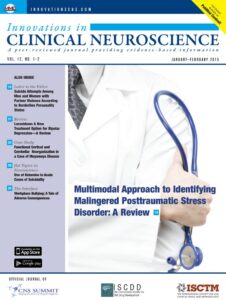 Innov Clin Neurosci. 2015;12(1–2):10–11.
Innov Clin Neurosci. 2015;12(1–2):10–11.
Dear Editor:
Borderline personality disorder (BPD) is associated with various aggressive behaviors toward persons, including partner violence, filicide (killing of one’s child), familicide (killing of one’s intimate partner and at least one child), and suicide attempts.[1,2] Moreover, severe personality disorders have been associated with homicide.[3–5] However, to our knowledge, no study has explored associations between BPD and past suicide attempts (i.e., self-aggression) in a population of individuals who exhibit violence toward partners. Explicitly, among a generally violent group of individuals, would the subsample with BPD symptomatology still be distinguished by suicide attempts?
Participants in this study were adult men and women in a mid-central state in the United States who were court-referred to one of four different treatment facilities (3 urban, 1 rural) for the perpetration of partner violence. Of the 235 individuals approached for participation, 193 agreed to participate, for a response rate of 82.1 percent. Of these, 170 were men and 23 were women. Because respondents were asked to indicate which of the listed age ranges applied to them, the precise ages of respondents are unknown. However, all respondents checked a range falling between 18 and 65 years of age, and most (71.5%) indicated an age between 21 and 40 years. The most common self-reported race or ethnicity was White/Caucasian (43.0%) followed by Black/African American (19.7%), Native American (14.5%), Hispanic/Latino (11.4%), Other (10.9%), and Asian (0.5%).
Four agencies participated in this study, which was reviewed and approved by an institutional review board. Investigators solicited and surveyed participants onsite. At the outset of treatment groups, the elements of informed consent were verbally reviewed with participants and then each signed a consent form. Surveys were then completed (24 different treatment groups). The survey initially inquired about demographic data. The next relevant survey section contained the Self-harm Inventory (SHI)—a measure of self-harm behavior and BPD symptomatology.[6] The SHI is a 22-item, yes/no, self-report inventory that explores participants’ histories of self-harm behavior. Each item in the inventory is preceded by the statement, “Have you ever intentionally, or on purpose,…” Individual items include, “overdosed,” “cut yourself,” “burned yourself,” “attempted suicide,” and “hit yourself.” Each endorsement increases the possibility of pathology. The SHI total score is the summation of “yes” responses. SHI total scores of 5 or greater are highly suggestive of the diagnosis of BPD.6 Indeed, in comparison with the Diagnostic Interview for Borderlines (DIB),[7] a benchmark measure for the diagnosis of BPD in research settings, the SHI at a cut-off of 5 demonstrated an accuracy in diagnosis of 84 percent and at a cut-off of 7, 88 percent.[6]
The item of interest (history of attempted suicide) was SHI item 18. Accordingly, that item was not included in the scoring of the SHI. Of the 193 respondents, 43 (22.3%) endorsed the SHI item pertaining to having ever intentionally attempted suicide and 106 (54.9%) exceeded the clinical cut-off score of 5 on the SHI, indicating substantial BPD symptomatology. Using a traditional cut-off score of 5 for BPD diagnosis, the rate of attempted suicide was statistically significantly greater among respondents who exceeded the cut-off (35.7%) compared to those respondents who did not (5.7%), Chi2=25.00, p These data indicate that among a violent group of men and women, violence toward self (suicide attempts) remains distinctive among the subsample with BPD symptomatology, regardless of the cut-off used on the SHI. Importantly, this suggests that individuals with partner violence who suffer from BPD demonstrate different clinical characteristics than their partner-violent peers—characteristics that need to be factored into an effective treatment for this subgroup of batterers. Given the observed loading for suicide attempts in the BPD subsample, Palermo et al[8] describe murder-suicide as an extended version of suicide—therefore, one wonders whether this characterological subgroup is at greater risk for murder-suicide.
The limitations of this study include the use of a self-report measure for BPD, a severe group of partner-violent individuals (i.e., the subjects were all court-ordered to treatment; therefore findings may not generalize to less severe individuals), and use of a single variable for suicide attempts. However, to our knowledge, this is the first study to confirm clinically distinguishing characteristics (e.g., suicide attempts) in a subgroup of partner violent individuals—those with BPD symptomatology.
References
1. Sansone RA, Sansone LA. Borderline personality and externalized aggression. Innov Clin Neurosci. 2012;9:23–26.
2. American Psychiatric Association. Diagnostic and Statistical Manual of Mental Disorders, Fifth Edition. Washington, DC: American Psychiatric Press, Inc.; 2013.
3. Shaw J, Appleby L, Amos T, et al. Mental disorder and clinical care in people convicted of homicide: national clinical survey. BMJ. 1999;318:1240–1244.
4. Medicott RW. Psychiatric aspects of murder and attempted murder. N Z Med J. 1976;83:5–9.
5. Petursson H, Gudjonsson GH. Psychiatric aspects of homicide. Acta Psychiatr Scand. 1981;64:363–372.
6. Sansone RA, Wiederman MW, Sansone LA. The Self-Harm Inventory (SHI): development of a scale for identifying self-destructive behaviors and borderline personality disorder. J Clin Psychol. 1998;54:973–983.
7. Kolb JE, Gunderson JG. Diagnosing borderlines with a semi-structured interview. Arch Gen Psychiatry. 1980;37:37–41.
8. Palermo GB, Smith MB, Jenzten JM, et al. Murder-suicide of the jealous paranoia type: a multicenter statistical pilot study. Am J Forensic Med Pathol. 1997;18:374–383.
With regards,
Randy A. Sansone, MD; Kenneth Elliott, PhD; and Michael W. Wiederman, PhD
Dr. Sansone is a Professor in the Departments of Psychiatry and Internal Medicine at Wright State University School of Medicine in Dayton, Ohio, and Director of Psychiatry Education at Kettering Medical Center in Kettering, Ohio. Dr. Elliott is an Adjunct Professor in the Advanced Professional and Special Services Department at the University of Central Oklahoma in Edmond, Oklahoma. Dr. Wiederman is Director of Faculty Development at the University of South Carolina School of Medicine-Greenville in Greenville, South Carolina.
Funding/financial disclosures: No funding was provided and the authors report no conflicts of interest relevant to the content of this letter.


